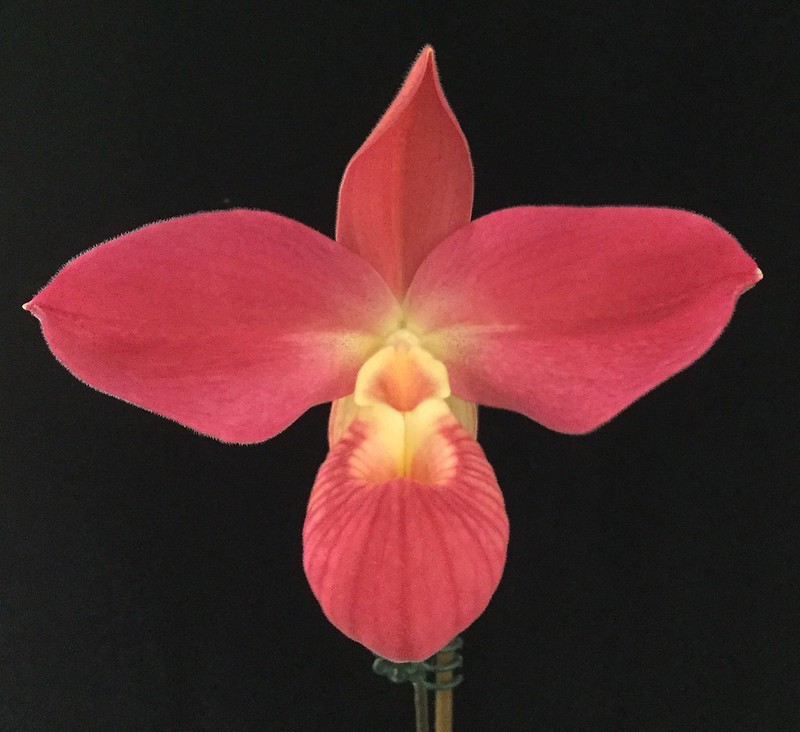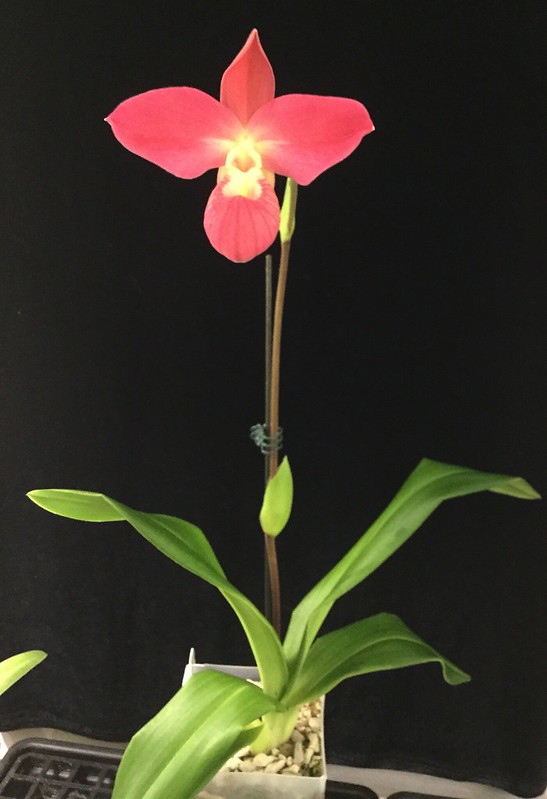Hopefully, links are now fixed.
Phrag Super Nova (Acker's Superstar X kovachii) was registered by Ken. Wilson in April 2015 but I cannot find an online image of the flower.
The flower in the link below is a first bloom (second growth because first growth did not bloom) from a cross done by Orchid's Limited, so Jerry Fischer, Jason Fischer, and Robert-Jan Quene were important in the creation and growth of this cross. Keep your expectations lowish as this was taken with an iPad!
 Phrag Super Nova by terryros, on Flickr
Phrag Super Nova by terryros, on Flickr
The kovachii used was 'Tesoro Morada' which may be the best of Orchid's Limited's kovachii clones. Jerry Fischer thinks it might be tetraploid because of flower size and how long the flowers last.
Acker's Superstar itself was registered in April 2003 by Chuck Acker and it is Eric Young X Jason Fischer, (62.5% besseae, 25% longifolium, and 12.5% sargentianum). There are not many online images of Acker’s Superstar but this is a link to a tetraploid version on Chuck Acker’s site. This is probably the plant used in this Orchids Limited Super Nova cross.
http://www.flasksbychuckacker.com/images/Acker's%20Superstar.JPG
Phrag Super Nova is thus 50% kovachii, 31.25% besseae, 12.5% longifolium, and 6.25% sargentinianum, making it about as complex as any Phrag hybrid gets.
This Super Nova opens flat for about a day and then develops a wavy forward curve. It never reflexes. The curve is shown in a side view in this link:
 Phrag Super Nova by terryros, on Flickr
Phrag Super Nova by terryros, on Flickr
Finally, for those who like to see the whole plant, here it is:
 Phrag Super Nova by terryros, on Flickr
Phrag Super Nova by terryros, on Flickr
This particular plant was grown and bloomed under LED lighting in a mix of GrowStone and milled sphagnum moss. The flower shown was the second (and final) bloom of the plant and had been open about 5 days open when the photo was taken. The first bloom lasted 11 days before falling off. The NS of the first flower was 11 cm and the petals and pouch were each 3.5 cm wide. Flattening the petals out would increase these measurements to 12 cm and 4 cm. The second flower was about 0.5 cm smaller in NS. Jerry Fischer thinks this plant may be able to get 3 flowers and the flowers will become larger for another growth or two if the conditions are good.
This bloom of Super Nova more closely resembles many Phrag Glen Decker (Jason Fischer x kovachii) pictures than Phrag Peruflora’s Spirit (Eric Young x kovachii) pictures, but the waviness of the petals is probably attributed to the longifolium.
Here is a link to one of the first Glen Deckers posted in Slippertalk:
http://i13.photobucket.com/albums/a285/DotBarnett/Slippertalk%20fixes/PhragGlenDecker.jpg
This a link to an Orchid’s Limited triploid Peruflora’s Spirt:
https://www.orchidweb.com/images/Product/medium/pfspiritm.jpg
If Drorchid (Robert-Jan Quene) is seeing this post, I would welcome his comments on the genetics of this complex cross since each of the four species in this cross may have different diploid chromosome counts. Think of the mess when all of these chromosome may be tetraploid! Robert started, and supplemented, a nice Slippertalk chain back in 2008 about chromosome numbers being different in different Phrag species and why it might be difficult to make very complex hybrids. Something tells me that Super Nova might be a dead end for breeding. Here is a link to that discussion:
http://www.slippertalk.com/forum/showthread.php?t=9360&highlight=Quene
Phrag Super Nova (Acker's Superstar X kovachii) was registered by Ken. Wilson in April 2015 but I cannot find an online image of the flower.
The flower in the link below is a first bloom (second growth because first growth did not bloom) from a cross done by Orchid's Limited, so Jerry Fischer, Jason Fischer, and Robert-Jan Quene were important in the creation and growth of this cross. Keep your expectations lowish as this was taken with an iPad!
 Phrag Super Nova by terryros, on Flickr
Phrag Super Nova by terryros, on FlickrThe kovachii used was 'Tesoro Morada' which may be the best of Orchid's Limited's kovachii clones. Jerry Fischer thinks it might be tetraploid because of flower size and how long the flowers last.
Acker's Superstar itself was registered in April 2003 by Chuck Acker and it is Eric Young X Jason Fischer, (62.5% besseae, 25% longifolium, and 12.5% sargentianum). There are not many online images of Acker’s Superstar but this is a link to a tetraploid version on Chuck Acker’s site. This is probably the plant used in this Orchids Limited Super Nova cross.
http://www.flasksbychuckacker.com/images/Acker's%20Superstar.JPG
Phrag Super Nova is thus 50% kovachii, 31.25% besseae, 12.5% longifolium, and 6.25% sargentinianum, making it about as complex as any Phrag hybrid gets.
This Super Nova opens flat for about a day and then develops a wavy forward curve. It never reflexes. The curve is shown in a side view in this link:
 Phrag Super Nova by terryros, on Flickr
Phrag Super Nova by terryros, on FlickrFinally, for those who like to see the whole plant, here it is:
 Phrag Super Nova by terryros, on Flickr
Phrag Super Nova by terryros, on FlickrThis particular plant was grown and bloomed under LED lighting in a mix of GrowStone and milled sphagnum moss. The flower shown was the second (and final) bloom of the plant and had been open about 5 days open when the photo was taken. The first bloom lasted 11 days before falling off. The NS of the first flower was 11 cm and the petals and pouch were each 3.5 cm wide. Flattening the petals out would increase these measurements to 12 cm and 4 cm. The second flower was about 0.5 cm smaller in NS. Jerry Fischer thinks this plant may be able to get 3 flowers and the flowers will become larger for another growth or two if the conditions are good.
This bloom of Super Nova more closely resembles many Phrag Glen Decker (Jason Fischer x kovachii) pictures than Phrag Peruflora’s Spirit (Eric Young x kovachii) pictures, but the waviness of the petals is probably attributed to the longifolium.
Here is a link to one of the first Glen Deckers posted in Slippertalk:
http://i13.photobucket.com/albums/a285/DotBarnett/Slippertalk%20fixes/PhragGlenDecker.jpg
This a link to an Orchid’s Limited triploid Peruflora’s Spirt:
https://www.orchidweb.com/images/Product/medium/pfspiritm.jpg
If Drorchid (Robert-Jan Quene) is seeing this post, I would welcome his comments on the genetics of this complex cross since each of the four species in this cross may have different diploid chromosome counts. Think of the mess when all of these chromosome may be tetraploid! Robert started, and supplemented, a nice Slippertalk chain back in 2008 about chromosome numbers being different in different Phrag species and why it might be difficult to make very complex hybrids. Something tells me that Super Nova might be a dead end for breeding. Here is a link to that discussion:
http://www.slippertalk.com/forum/showthread.php?t=9360&highlight=Quene
Last edited:














































